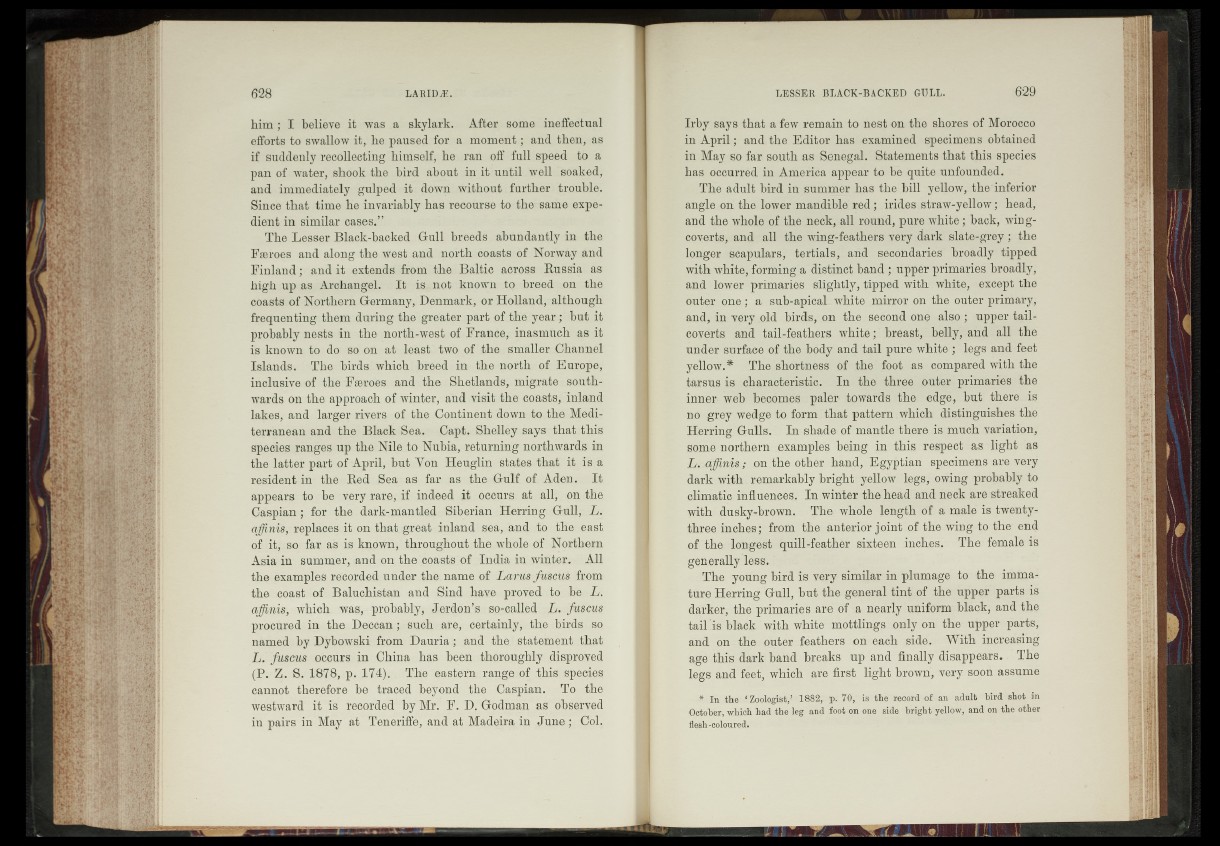
him; I believe it was a skylark. After some ineffectual
efforts to swallow it, he paused for a moment; and then, as
if suddenly recollecting himself, he ran off full,speed to a
pan of water, shook the bird about in it until well soaked,
and immediately gulped it down without{ further trouble.
Since that time he invariably has recourse tctet^elsame expedient
in similar cases.”
The Lesser Black-backed Gull breedsf abundantly in the.
Faeroes and along the west and north coasts of Norway and
Finland; and it extends from the Baltic across Russia as
high up as Archangel. It i%not known to breed on the
coasts of Northern Germany, Denmark, or Holland, although
frequenting them during the greater part of the yearf^but it
probably nests in the north-west of France,- inasmuch as it
is known to do so on. a t beast two of the smaller.Gbuftnel
Islands. The birds which breed in- the -north? of Europe,
inclusive .of therFssro’es and the Shetlands,. migrate,tSouthwards
on the approach of winter, and .-visit the. coasts, inland
lakes, and larger river% .of, the Lontincndlr. down .»to the Mediterranean
and the Black Sea. papjL Shelley says thatit^ie
species ranges up the Nile to Nubia,-rethfni^irkQrthwards in
the latter part of-April, but Heuglin states that; i%4l,a
resident in- the Red Sea as faiv^srJhe Gulf of. Ad,en-.-£:d%
appears .to be very rare, if indeed At ouomjgi. at. ail1; on the
Caspian ; for the dark-mantled Siberian .-Herring Gull,-,L.,
affinis, replaces it on that .great • inland [ seafood, to the*-.east
of it,jp& far as is known,' throughout the wtfeleidL-Northern
Asia in summer, and on tho coasts.of India in winter. i'All
the examples recorded*under the, name of, Larus fyj%aws Jfrem-
the coast iof?: Baluchistan and Sind have,■ provedat©rbe;'L.
affinis:, which was,—probably^ Jordon’S;-SQjcalled' Jj.z-fijmus.
procured in the Deccan ; snch iare, certainly,..the -birds , g&i
named by Dybowski from Da-uria ; and the rSta.te.flae-B.ti that
L.'"juseus occurs in China a.ha,s been rtheronghly disproved
(P. Z. S.* lB78,.p. 174).- The eastern; rapggmf thisi-specie^
cannot therefore be traced beyond the Caspian. To the
westward i£ is recorded by Mr. F. D.'Godman as db^qryed
in pairs "in May at Tenerifie, and at Madeira in June; £jolj
Irby says that a, few remain to nest on the shores of Morocco
in April ; and the Editor has examined specimens obtained
pî May so far south as Sénégal, ? -Statements that this-species
has occurred in America appear to be quite unfounded. !
>..jThe adult bird in summer has the bill yellow, the'inferior
angle on the lower mandible red ; .irides straw-yellow ; head,
and the whole of the neck, all round, pure white gback, win g-
goyerts,- and all the wing-feathers very dark slate-grey the
longer-scapulars, tertials, and secondaries' broadly • tipped
with white, forming a distinct band ;■ upper primaries broadiyy
and lower primaries slightly, .tipped with white, except the
outer: ghg ; a > sub^apicaL white ?imrrOT on themuter primary,*
and, in very old bir«Js, on the, second one^-uisp. ; upper taih
coverts and tail-feathers, zwhite^L breast,'* belly, and all the
under surface óf the .body; and tail pure' white';wlegs hndffeel
■yellow.* The .shortness of fhe Joot as pompared with the
tarsus is characteristic . - I n the thyeedputer primaries the
inner-web’ becomes paler towards’ - the. - edge, but there.: is
no grey wèdgeto form'that pattern,which distinguishes the
Herring Gulls. In shade of mantle ^hésre isunuch variation,
gome northern examples b#ngs. in this respect 'as.'light?. Has
pn the other.-hand,: Egyptian specimens are very
dark with,remarkably bright, yellow-%gs-,owing probably to
.climatic influencés. In winter -fhe'head and neck are streaked
with du sky-brown. The' wbdlelength of a male’ is, twenty«
three inchqg-h from Æâ^anterior jointtof .the wing to "the* end
of f he ■ 4ohgtsV?quill-feathér sixteen: inches! 'The*' female is
generally
■ The young bird is very similar in plumage to the- imipà*
ture Herring Gull, but the-general tint’o f the upper parts is
darker, £he‘primaries are of ;a neally uniform'black; and the
tailbsiblack with white -BièttlîmgrônTyhm the* upper parts,
and’Abythe outer-.feathers iomeach side:; With increasing
âgé this/dark band breaks up and finally iès%>peaæA . The
legs and feet, which are first light brown, very soon assume
* In ths’s-A-ZooIo^t^l^ll'^P-v ^ j^ i^ h e * -record^L an adult bird shot in
October, -which had the teg andïoot on ope side bright ’-yellow, ahd on the other
fleâh-etfloürédîSHl